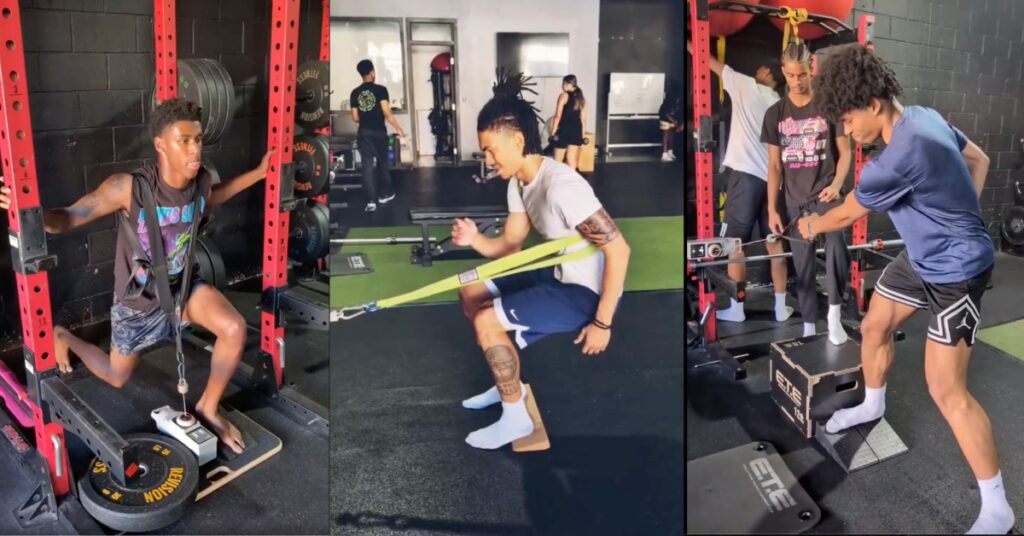These include traditional cable machine resistance, lighter resistance modes for speed (think Vertimax), eccentric-overload aka flywheel settings, chain resistance, as well as adaptive isokinetic resistance. Some of those have been added over time to my pre-existing unit (they’re still in startup mode) via their software upgrades with potentially more to come in time. I’ll do my best to summarize the various features here.
- Weight Training Mode feels like an ultra-smooth cable machine. Think Keiser Functional Trainer-esque. This would be like traditional isotonic resistance you can preload prior to performing an exercise.
�
- You can add a flywheel feeling component by adding additional resistance to the eccentric portion of the movement.
�
- You can also add a chain-resistance-mimicking setting to this mode where resistance gets heavier the further you progress through the concentric phase of movement—similar to real chains on, say, a squat.
�
- Damper Mode simulates the resistance experienced during a parachute run with resistance increasing as speed increases.
�
- Resistance Band Mode sees the resistance increase as the range of motion increases, akin to a literal resistance band. This is ideal for movements where speed is the goal, such as loading a first step, lateral push off, and other athletic patterns.
�
- Isokinetic Mode provides adaptive resistance to the user on the concentric phase of movement with no eccentric load. This means the harder the user pulls or pushes, the more resistance the machine offers in order to adapt to the user’s given capabilities. This is highly useful as each rep is a living, adaptable, relative max. It’s also pragmatic because multiple athletes of various physical abilities can work on the same machine concurrently.
Those are the main settings; the machine, however, also has other qualities that really tie everything together.
Weight Training Mode feels like an ultra-smooth cable machine. Think Keiser Functional Trainer-esque. This would be like traditional isotonic resistance you can preload prior to performing an exercise, says @rewirehp.Share on X
The various attachments and accessories are very helpful. I’m a big fan of the rack attachments (including the new one that rotates in whatever direction it’s pulled for cleaner movement setups) as well as the base for vertical plane of movement exercises. The various settings are largely intuitive, with some light experimentation, so the whole thing is quite user friendly. Even some of the more functional/practical settings like the cable rollback are reasonably easy to figure out on your own. All in all, it was nice to dive into a piece of technology without feeling overwhelmed in start-up mode.
Who Is It For?
I personally view the VOLTRA I as something that’s soon-to-be ubiquitous across virtually all physical fitness, rehabilitation, and performance arenas with benefits to offer everybody.
It certainly has a place in home fitness due to the minimal fingerprint and sheer amount of boxes it can help you check (cable machine, flywheel, isokinetic machine, Vertimax-type settings, chain resistance mimetic).
That same Swiss Army Knife offering of features plus the minimal footprint makes it ideal for boutique gyms and training studios that want to integrate various pieces of equipment with those features but may not have adequate floor space.
Speaking of the portability and small footprint aspect relative to features, the machine should legit be considered a must-have for all mobile or pop-up trainers. Those familiar with the scarce resources for some professional sports training staff when on the road (e.g., in the NBA) are likely already thinking of this as something they can bring along on road trips for sports teams. This has implications for pre-game prep and being able to get athletes sufficient post-game load on the road. I can see tissue recruitment/potentiation and movement prep benefits prior to competition as a key area it addresses.
The performance benefits make the VOLTRA I an ideal choice for athletes as well as those who train them. This can include speed coaches, strength and conditioning coaches, and rehabilitation specialists who want a reasonably cost-effective, convenient solution for reconditioning and return-to-play needs. The isokinetic mode in particular—being able to match the output of the user—means athletes are offered scaled challenges relative to the level of their present abilities.

